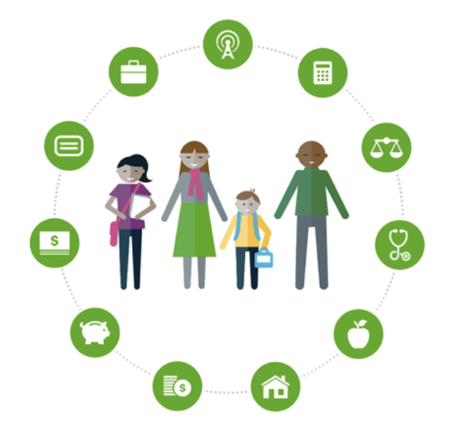
Connecting students to State, local, Federal and community benefits

Brief History
The Single Stop program began in the basement of a church in a poor neighborhood in West Philadelphia and found its way to New York City in 1990. In 2002, the concept was brought to the Robin Hood Foundation, an anti-poverty charity operating in New York City, which proceeded to create Single Stop sites through partnerships with community-based organizations. Single Stop is a one-stop offering support to students in meeting their basic needs.
Single Stop Mission
Single Stop is a one-stop resource center offering students holistic guidance grounded in equity, respect and trust focused on providing basic needs assistance. Through inclusive coordinated access to local, state, federal, and community-based organizations, Single Stop strives to build economic mobility needed to increase persistence, retention, and graduation rates.
Statement to our Students
- We are committed to helping you be successful. We understand that at times you may be facing financial difficulties and we want to help. You are not alone.
- If you are having trouble affording basic needs, please let us know. We are fortunate to be working with several groups that may be able to help you.
Practicing Equity
Single Stop defines equity as:
- consistent
- systematic
- fair
- just, and
- impartial
This includes underserved communities who have been denied equitable treatment, such as Black, Latino, Indigenous and Native American persons, Asian Americans and Pacific Islanders, and other persons of color; members of religious minorities; lesbian, gay, bisexual, transgender, and queer (LGBTQ+) persons; persons with disabilities; and persons adversely affected by persistent poverty or inequality.
Practicing equity links to our service design, delivery methods, and the quality of the services itself. To ensure equity, our program considerations are as follows:
1. Ensuring technology to meet service and equity needs through virtual services when in-person is difficult or not available through the following delivery methods:
- video
- telephone
- text
- chat
- or another designated platform such as Moodle
Virtual services may be easier to access than in-person services for students who lack transportation or childcare, thus improving equity. Students with limited access to broadband and technological devices such as laptops are eligible to receive assistance from the College and for those individuals with disabilities requiring specific platforms, our office works collaboratively with Disability Services.
2. Focusing on equity before and during initial outreach
Single Stop staff recognizes the inequities students face. When targeting program services such as SNAP eligibility, staff ensures that they are targeting students who are 22 and older who are receiving Financial Aid Pell Grant (form of need-based federal financial aid that typically does not have to be repaid) In this regard, Single Stop avoids systematically excluding any populations, particularly when outreach occurs virtually or through hybrid (in-person and virtual) methods.
Regardless of the method for delivering services, staff consider the equity implications of how they outreach to avoid making it harder for students to equitably access services and achieve the intended outcomes.
Through the outreach process, staff learns more about students’ needs and can connect them to services and resources through universal screenings of needs and streamlined eligibility, whether assessments are conducted virtually or in person. Connecting students to services regardless of whether they reached out in person, over the telephone, or virtually enhances the program's ability to serve more students improving outcomes and potentially reducing inequities.
3. Redesigning services to align with students' needs and tailoring approaches to enhance equity
To improve equity, Single Stop enables student's needs to drive service design and build in meaningful, ongoing student-centered programming such as offering each semester information on basic needs. Also, Single Stop explores how service quality varies across different delivery methods to ensure equity regardless of access or delivery method. Gauging students' needs is critical to providing services that students need and want. For example, the transition to electronic signatures helped students access services such emergency, textbook, computer, and transportation assistance excreta.

